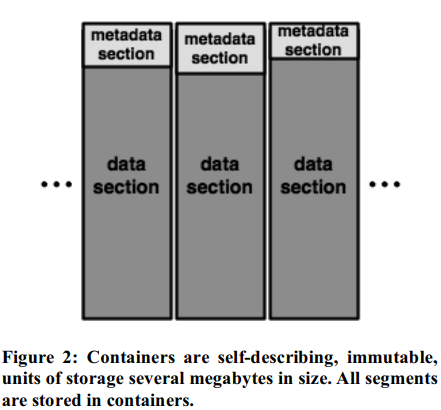Avoiding the Disk Bottleneck in the Data Domain Deduplication File System
| Venue | Category |
|---|---|
| FAST'08 | Secure Deduplication |
Avoiding the Disk Bottleneck in the Data Domain Deduplication File System1. SummaryMotivation of this paperReduce the need for on-disk index lookups during the deduplicaiton processImplementation and Evaluation2. Strength (Contributions of the paper)3. Weakness (Limitations of the paper)4. Future Works
1. Summary
Motivation of this paper
This paper wants to investigate how to do deduplication at high speed in order to meet the performance requirement for secondary storage used for data protection.
how to implement a high-throughput identical chunk deduplication storage system at low system cost reduce disk I/Os in high-throughput deduplication storage system.
Traditional method: maintain an on-disk index of segment (chunk) and use a cache to accelerate segment index access
the cache hit ratios is low: fingerprint values are random, no spatial locality, very little temporal locality. cause the real performance of deduplication cannot compete with high-end tape libraries. (i.e., 100MB/sec)
Reduce the need for on-disk index lookups during the deduplicaiton process
- Key idea:
- a Bloom filter, which it calls a Summary Vector, to test if a data segment is new to the system.
avoid wasted lookups for unexisted segments.
- Stream-Informed Segment Layout (SISL): store data segments and their fingerprints in the same order that they occur in a data file or stream
creates spatial locality
- Locality Preserved Caching: fetch and cache groups of segment fingerprints that are likely to be accessed together.
- Performance-Capacity Balance Given a particular storage capacity, backup policy, and deduplication efficiency, it is possible to compute the throughput that the system must sustain to justify the capacity.
- Storage System Architecture in Data Domain (DDFS) The stack architecture of Data Domain File System (DDFS):
Content Store: break a data stream into segments (chunking). Segment Store: perform deduplication. (does the actual work of deduplication), also does the data compression to further compress the data size, and writes compressed results into containers supported by Container Manager.
- Content Store Object: an object is a linear sequence of client data bytes.
- chunking: byte range variable-length segments
- compute fingerprint: SHA-1 hash
- segment mapping: builds the tree of segments that records the mapping between object byte ranges and segment descriptors.
- Segment Store
- A database of segments keyed by their segment descriptors.
- Segment filtering: key operation to deduplicated segments, may trigger disk I/Os.
- Container packing: adds segments to be stored to a container which is the unit of storage in the system. A container when fully packed, is appended to the Container Manager.
- Segment indexing update: segment index the container holder.
- Container Manager
- allocating, deallocating, reading, writing and reliably storing containers.
- built on top of standard block storage
- Acceleration Methods
- Summary vector it indicates whether the segment is in the index or not.
a bloom filter to summarize the existence information about fingerprints in the segment index. choose the basic Bloom Filter for simplicity and efficient implementation.
- Stream informed segment layout (stream-aware)
enable locality preserved caching, create spatial locality. Segment duplicate locality: when new data contains a duplicate segment , there is high probability that other segments in its locale are duplicates of the neighbors of . stream abstraction: segregates the segments created for different objects, preserves the logical ordering of segments within the Content Store. dedicated container holds segments for a single stream.
Benefits:
- multiple segments of the same data stream are written to a container together, reduce disk I/Os, and achieve high read throughput.
- Locality preserved caching (LPC) maintain the segment cache by groups of fingerprints.
LPC will fetch the entire metadata section in a container, insert all fingerprints in the metadata section into the cache. Intuition: base segments in this containers are likely to be checked against for future duplicate segments.
- Whole workflow (write) for an incoming segment
- check to see if this segment is in the segment cache
- check the Summary Vector, and lookup the segment index for its containers ID, insert the metadata section of that container into the segment cache.
Implementation and Evaluation
- Trace Analysis: shows the deduplication storage system works well with the real world datasets.
cumulative total compression ratios increase as the system holds more backup data.
- I/O savings with summary vector and locality preserved caching
measure the number of disk reads for segment index lookups and locality prefetches.
- Thoughput (with synthetic datasets)
write throughput is more important than read throughput
2. Strength (Contributions of the paper)
- The logic of this paper is very clear, it identifies the disk I/Os are the bottleneck of deduplication throughput. And, it proposes three methods to mitigate the effect of disk I/Os.
- The system described in this paper is very practical, and has been used at over 1,000 data centers.
3. Weakness (Limitations of the paper)
- One limitation of this paper is it does not consider the case of restore operation in the long term retention.
4. Future Works
- This work verifies that the system with content-based segmentation gets a lot of global compression.
- This work also mentions fragmentation will become more svere for long term retention, and can reduce the effectiveness of caching.
